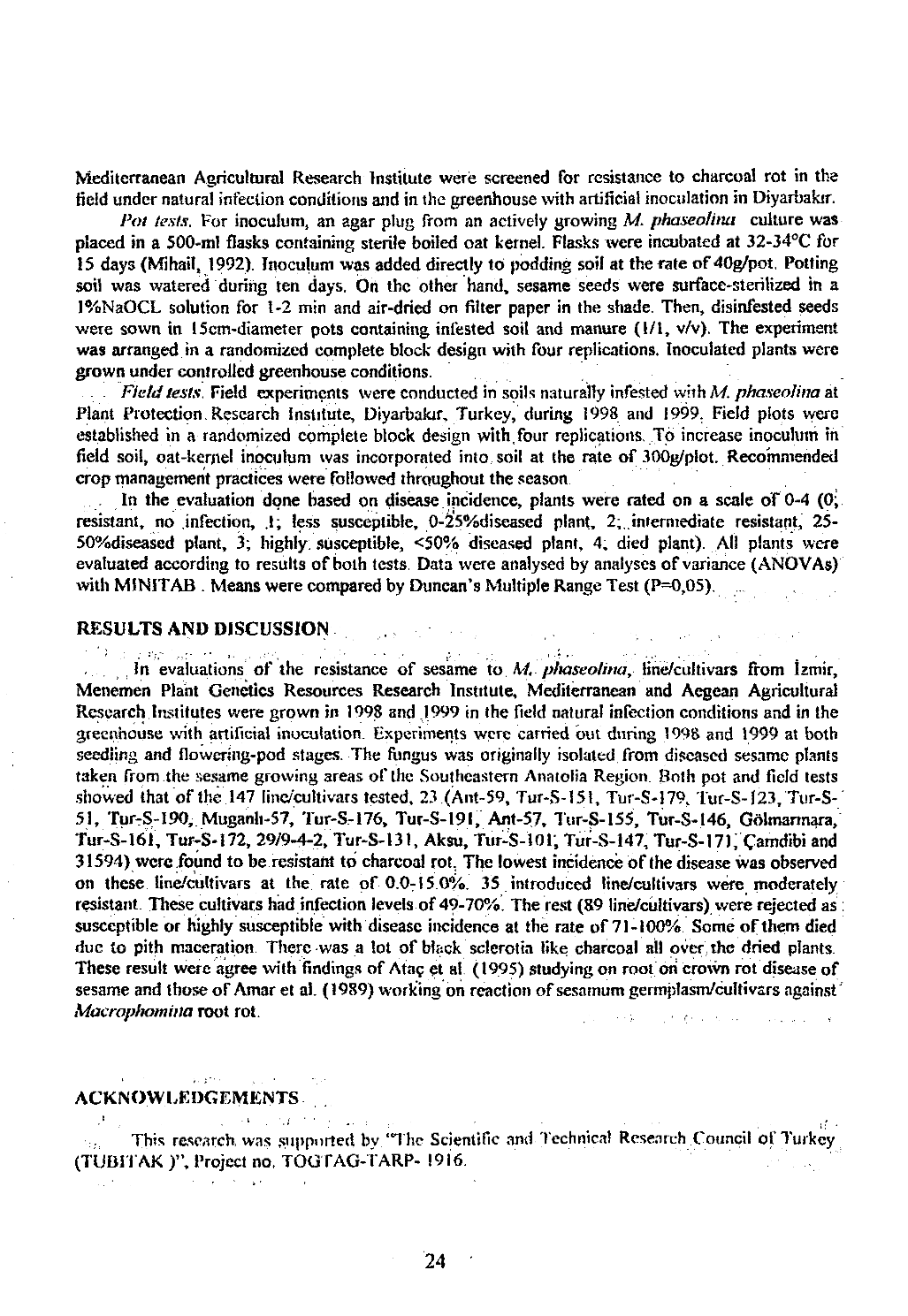

Mediterranean Agricultural Research Institute were screened for resistance to charcoal rot in the
field under natural infection conditions and in the greenhouse with artificial inoculation in Diyarbakir.
Pot tests.
For inoculum, an agar plug from an actively growing M
phaseofitui
culture was
placed in a 500-ml flasks containing sterile boiled oat kernel. Flasks were incubated at 32-34°C for
15 days (Mihail, 1992). Inoculum was added directly to podding soil at the rate o f 40g/pot. Potting
soil was watered during ten days. On the other hand, sesame seeds were surface-sterilized in a
!%NaOCL solution for 1-2 min and air-dried on filter paper in the shade. Then, disinfested seeds
were sown in I5cm-diameter pots containing infested soil and manure ( l/l, v/v). The experiment
was arranged in a randomized complete block design with four replications. Inoculated plants were
grown under controlled greenhouse conditions.
Field tests.
Field experiments were conducted in soils naturally infested with
M. phaseolina
at
Plant Protection, Research Institute, Diyarbakir, Turkey, during
1998
and
1999.
Field plots were
established in a randomized complete block design with four replications. To increase inoculum in
field soil, oat-kernel inoculum was incorporated into soil at the rate o f 300g/plot. Recommended
crop management practices were followed throughout the season
In the evaluation done based on disease incidence, plants were rated on a scale o f 0-4 (0;
resistant, no infection, ,1; less susceptible, 0-25%diseased plant, 2;..intermediate resistant, 25-
50%diseascd plant, 3; highly susceptible, <50% diseased plant, 4, died plant). All plants were
evaluated according to results o f both tests, Data were analysed by analyses of variance (ANOVAs)
with MINITAB . Means were compared by Duncan’s Multiple Range Test (IM),05).
RESULTS AND DISCUSSION
In evaluations o f the resistance o f sesame to
M. pltaseolina,
line/cultivars from Izmir,
Menemen Plant Genetics Resources Research Institute, Mediterranean and Aegean Agricultural
Research Institutes were grown in 1998 and ,1999 in the field natural infection conditions and in the
greenhouse with artificial inoculation. Experiments were carried out during 1998 and 1999 at both
seedling and flowering-pod stages. The fungus was originally isolated from diseased sesame plants
taken from the sesame growing areas o f the Southeastern Anatolia Region Both pot and field tests
showed that o f the 147 linc/cultivars tested, 23 (Ant-59, Tur-5-151, Tur-S-179, Tur-S-123, Tur-S-
51, Tur-S-190,. Muganli-57, Tur-S-176, Tur-S-191, Ant-57, Tur-S-155, Tur-S-146, Golmarmara,
Tur-S-161, Tur-S-172, 29/9-4-2, Tur-S-131, Aksu, Tur-S-101; Tur-S-147, Tur-S-17i; Camdibi and
31594) were found to be resistant to charcoal rot. The lowest incidence o f the disease was observed
on these line/cultivars at the rate o f 0.0-15.0%. 35 introduced line/cultivars were moderately
resistant. These cultivate had infection levels of 49-70%. The rest (89 line/cultivars) were rejected as :
susceptible or highly susceptible with disease incidence at the rate o f 71-100% Some o f them died
due to pith maceration There was a lot of black sclerotia like charcoal all over the dried plants.
These result were agree with findings of Ata$ et a! (1995) studying on root on crown rot disease o f
sesame and those o f Amar et al. (1989) working on reaction of sesamum germplasm/cultivars against
Macropltomina
root rot.
ACKNOWLEDGEMENTS
•(
This research was supported by “ The Scientific and Technical Research Council of Turkey
(TUB1TAK )”, Project no. TOGTAG-I ARP- 1916.
24
Научная электронная библиотека ЦНСХБ









